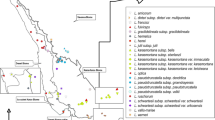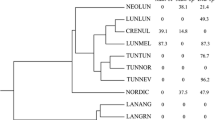Abstract
Sixty-one populations ofLimnanthes sect.Reflexae were surveyed for variation at 19 allozyme loci and reassessed for their morphological diversity and biosystematic relationships. Cluster analysis of allozyme data at individual population level provided evidence for a fairly good fit with the earlier systematic work on this genus but both morphological and allozyme data together defined some new clusters as well as exceptional entities. For example, only var.rosea of the fourL. douglasii varieties described byMason (1952) on the basis of geographical distribution, flower color and leaf morphology, remained as a distinct entity; the others were realigned along new geographic boundaries.L. striata appeared to have two well-developed subgroups, one of which was closely related to theL. douglasii complex. Further ecogeographic and hybridization studies are needed to fully describe these new phenetic findings in the context of phylogenetic inference. SectionInflexae was readily distinguished from sect.Reflexae by several diagnostic loci, thus supporting the validity of this division. Interspecific variation levels and population differentiation inLimnanthes were high when compared to other plant taxa, possibly indicating highly dynamic evolutionary processes for which variable habitats and extreme subdivision within species have been suggested as explanations.
Similar content being viewed by others
References
Anderson, W. W., Ayala, F. J., Michod, R. E., 1977: Chromosomal and allozyme diagnosis of three species ofDrosophila. — J. Hered.68, 71–74.
Avise, J. C., Aquadaro, C. F., 1982: A comparative summary of genetic distances in the vertebrates: Patterns and correlations. — Evol. Biol.15, 151–185.
Ayala, F. J., Tracey, M. L., Hedgecock, D., Richmond, R. C., 1974: Genetic differentiation during speciation process inDrosophila. — Evolution28, 576–592.
Crawford, D. J., Wilson, H. D., 1979: Allozyme variation in several closely related diploid species ofChenopodium of western United States. — Amer. J. Bot.66, 237–244.
Dixon, W. J., Brown, M. B., Engelman, L., Frame, J. W., Hill, M. A., Jennrich, R. I., Toporek, J. D., 1981: BMDP Statistical Software. — Univ. of Calif. Press, Berkeley.
Duncan, T., Baum, B. R., 1981: Numerical phenetics: Its uses in botanical systematics. — Ann. Rev. Ecol. Syst.12, 387–404.
Gottlieb, L. D., 1973: Enzyme differentiation and phylogeny inClarkia franciscana, C. rubicunda andC. amoena. — Evolution27, 205–214.
—, 1974: Genetic confirmation of the origin ofClarkia lingulata. — Evolution28, 244–250.
—, 1981: Electrophoretic evidence and plant populations. — Progress in Phytochemistry7, 1–46.
Hauptli, H., Webster, S. K., 1978: Variation in nutlet morphology ofLimnanthes. — Amer. J. Bot.65, 615–624.
Jain, S. K., Moyle, P., (Ed.), 1984: Vernal Pools and Intermittent Streams. — Institute of Ecology, Univ. Calif., Davis, 278 pp.
Levin, D. A., 1977: The organization of genetic diversity inPhlox drummondii. — Evolution31, 477–494.
—, 1978: Genetic variation in annualPhlox: Self-compatible versus self-incompatible species. — Evolution32, 245–263.
Lewontin, R. C., 1974: The Genetics Basis of Evolutionary Change. — New York: Columbia Univ. Press.
Mason, C. T., Jr., 1952: A systematic study of the genusLimnanthes R. Br. Univ. Calif. Publ. Bot.25, 455–512.
McNeill, C. I., Jain, S. K., 1983: Genetic differentiation studies and phylogenetic inference in the plant genusLimnanthes (SectionInflexae). — Theor. Appl. Genet.66, 257–269.
Mueller, L. D., 1979: A comparison of two methods for making statistical inferences on Nei's measure of genetic distance. — Biometrics35, 757–763.
Munz, P. A., Keck, D. D., 1959: A California Flora. — Berkeley: Univ. Calif. Press.
Nei, M., 1972: Genetic distance between populations. — Amer. Nat.106, 283–292.
—, 1973: Analysis of gene diversity in subdivided populations. — Proc. Nat. Acad. Sci.70, 3321–3323.
Ornduff, R., 1969:Limnanthes vinculans, a new California endemic. — Brittonia21, 11–14.
—, 1971: Systematic studies ofLimnanthaceae. — Madroño21, 103–111.
—, 1968: Numerical taxonomy ofLimnanthaceae. — Amer. J. Bot.55, 173–182.
Raven, P. H., 1976: Systematics and plant population biology. — Syst. Bot.1, 284–316.
—, 1978: Origin and Relationships of the California Flora. — Berkeley: Univ. of Calif. Press.
-Raven, T. E., 1976: The genusEpilobium in Australasia. — New Zealand Dept. of Scientific and Industrial Research Bulletin216.
Rick, C. M., Kesicki, E., Fobes, J. F., Holle, M., 1976: Genetic and biosystematic studies on two new sibling species ofLycopersicon from interandean Peru. — Theor. Appl. Genetics47, 55–68.
Sharitz, R. R., Wineriter, S. A., Smith, M. H., Liu, E. H., 1980: Comparison of isozymes amongTypha species in the eastern United States. — Amer. J. Bot.67, 1297–1303.
Sneath, P. H. A., Sokal, R. R., 1973: Numerical Taxonomy. — San Francisco: W. H. Freeman.
Stebbins, G. L., 1974: Flowering Plants, Evolution Above the Species Level. — Cambridge: Belknap Press.
—, 1965: Endemism and speciation in the California flora. — Ecol. Monogr.35, 1–35.
Tansley, S., Orton, T., (Eds.), 1983: Isozymes: Genetics and Breeding. — Amsterdam: Elsevier.
Templeton, A. R., 1981: Mechanism of speciation—a population genetic approach. — Ann. Rev. Ecol. Syst.12, 23–48.
Thorpe, J. P., 1982: The molecular clock hypothesis: Biochemical evolution, genetic differentiation and systematics. — Ann. Rev. Ecol. Syst.13, 139–168.
Vickery, R. K., Jr., 1978: Case studies in the evolution of species complexes inMimulus. — Evol. Biol.11, 405–507.
Wake, D. B., 1981: The application of allozyme evidence to problems in the evolution of morphology. — In: Evolution Today, Proc. Sec. Int. Congr. Syst. Evol. Biol. (Scudder, G. G. E., Reveal, J. L., eds.), pp. 257–270.
White, M. J. D., 1978: Modes of Speciation. — San Francisco: Freeman.
Author information
Authors and Affiliations
Rights and permissions
About this article
Cite this article
Kesseli, R.V., Jain, S.K. New variation and biosystematic patterns detected by allozyme and morphological comparisons inLimnanthes sect.Reflexae (Limnanthaceae). Pl Syst Evol 147, 133–165 (1984). https://doi.org/10.1007/BF00984586
Received:
Issue Date:
DOI: https://doi.org/10.1007/BF00984586




